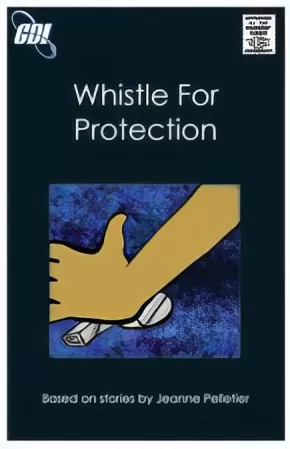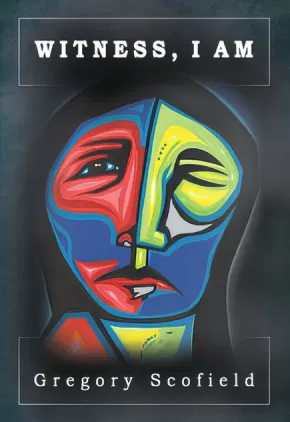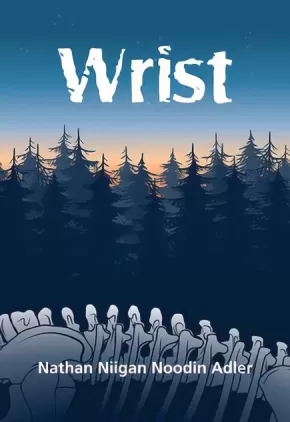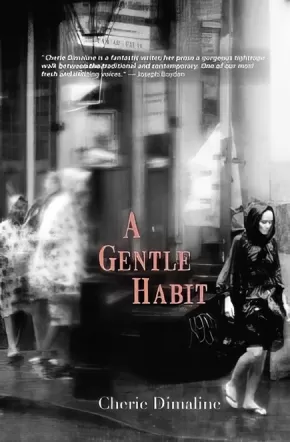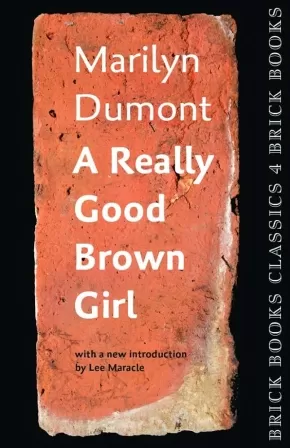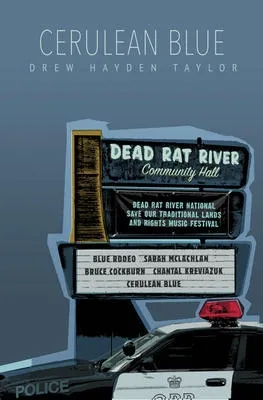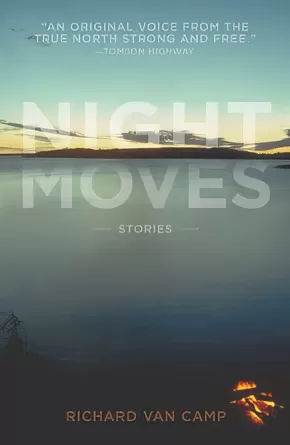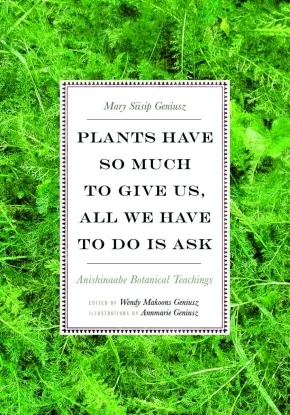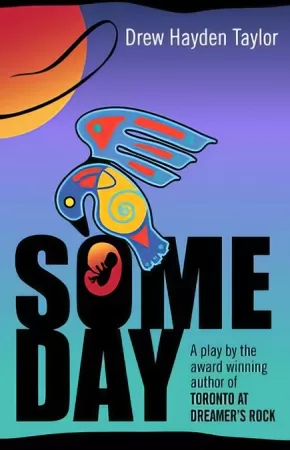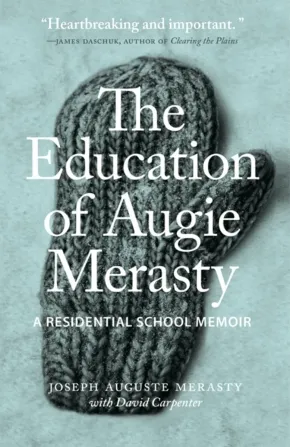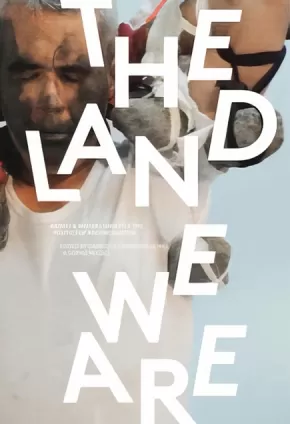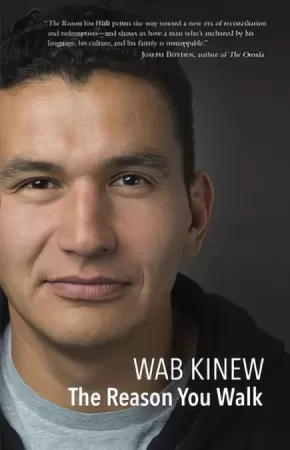
Indigenous Peoples in Canada
691
-
705
of
883 Results;
Sort By
Go To
of 59
Whistle for Protection
$5.00
Artists:
Format:
Paperback
Text Content Territories:
Indigenous Canadian; Métis;
ISBN / Barcode: 9781926795751
Synopsis:
Synopsis:
This is the third book in the Stories of Our People series.
Educator & Series Information
Stories of Our People/Lii zistwayr di la naasyoon di Michif Series is a departure from other books about Aboriginal or traditional stories. It includes five stories. As readers go through the series, they will notice that the narrative and artwork gets progressively darker. The series starts with trickster stories, then moves to a Whiitigo and Paakuk story, then jumps to a story about selling one’s soul and personal redemption, and finally to a Roogaroo story.
This project came to life from the stories of our Elders, and as such, original transcripts of the stories, prose renditions by Janice DePeel, and biographies of the storytellers and project team are available on the Virtual Museum of Métis History and Culture: www.metismuseum.ca/browse/index.php?id=13100
Based on stories by Norman Fleury, Gilbert Pelletier, Jeanne Pelletier, Joe Welsh, and Norma Welsh.
Stories of Our People/Lii zistwayr di la naasyoon di Michif Series:
Book 1: How Michif was Lost
Book 2: Chi-Jean and the Red Willows
Book 3: Whistle for Protection
Book 4: Sins of the Righteous
Book 5: Attack of the Roogaroos!
Witness, I Am
$18.95
Format:
Paperback
Text Content Territories:
Indigenous Canadian;
ISBN / Barcode: 9780889713239
Synopsis:
Synopsis:
Witness, I Am is divided into three gripping sections of new poetry from one of Canada's most recognized poets. The first part of the book, "Dangerous Sound," contains contemporary themed poems about identity and belonging, undone and rendered into modern sound poetry. "Muskrat Woman," the middle part of the book, is a breathtaking epic poem that considers the issue of missing and murdered indigenous women through the reimagining and retelling of a sacred Cree creation story. The final section of the book, "Ghost Dance," raids the autobiographical so often found in Scofield's poetry, weaving the personal and universal into a tapestry of sharp poetic luminosity. From "Killer," Scofield eerily slices the dreadful in with the exquisite: "I could, this day of proficient blooms, / take your fingers, / tie them down one by one. This one for the runaway, / this one for the joker, / this one for the sass-talker, / this one for the judge, / this one for the jury. / Oh, I could kill you."
Educator Information
Recommended for students in grades 11 and 12, or at a college/university level, for courses in creative writing, English First Peoples, English, poetry, and English language arts.
Caution: explicit coarse and sexual language.
Additional Information
96 pages | 5.50" x 8.00"
Wrist
$19.95
Format:
Paperback
Text Content Territories:
Indigenous Canadian; First Nations; Anishinaabeg; Ojibway;
ISBN / Barcode: 9781928120056
Synopsis:
Synopsis:
An Indigenous monster story.
In 1872, dinosaur hunters become embroiled in a battle over the discovery of fossils in Northern Ontario as their excavation crews are driven mad by a bizarre and terrifying illness. Over a hundred years later, Church and his family show signs of the same monstrous affliction. As he begins to unravel his family's dark history, Church must race to protect the secrets buried deep in bones and blood. Set in the fictional town of Sterling and Ghost Lake Reserve, Wrist is Nathan Adler's debut novel.
Reviews
“A forest doesn’t know what the future holds, but it is patient.” I love how Adler solicits the assistance of the natural world in weaving his magical tale - fantastic, captivating from beginning to end. Meet the fantastic world of Adler’s people and follow their journey through Ojibway life and story. Adler peppers the story with the rhythmic sound of Ojibway and it seems to help tell the story in the same way the natural world helps tell the story.” – Lee Maracle, author of Celia’s Song
"Nathan Adler writes exceptionally well. His words weave together and tell a haunting story that leaves you wanting more." -Christine Smith (McFarlane), Freelance Journalist
"With a unique voice and narrative, Nathan Adler blends poetic imagery and Anishinaabe story to create something totally new and completely beautiful." – Cherie Dimaline, author of A Gentle Habit, The Girl Who Grew a Galaxy, and Red Rooms
Additional Information
198 pages | 5.50" x 8.50"
A Gentle Habit
$24.00
Format:
Paperback
Text Content Territories:
Indigenous Canadian;
Grade Levels: 12; University/College;
ISBN / Barcode: 9781928120025
Synopsis:
Synopsis:
A short story collection by Cherie Dimaline.
The inspiration for the collection comes from American Poet Charles Bukowski who wrote "In between the punctuating agonies, life is such a gentle habit." Following this theme of extraordinary ordinariness, A Gentle Habit is a collection of six new short stories focusing on the addictions of a diverse group of characters attempting normalcy in an unnatural world.
Reviews
"Cherie Dimaline is a fantastic writer, her prose a gorgeous tightrope walk between the traditional and contemporary. One of our most fresh and exciting voices." - Joseph Boyden, author of award-winning novel The Orenda.
“Cherie Dimaline has strongly established herself as a gifted, essential voice in the vibrant realm of global Indigenous literature. The compelling journeys she creates for her richly complex characters invoke the profound storytelling of her Anishinaabe heritage. With A Gentle Habit, Dimaline delivers yet another beautiful set of influential stories that take modern Indigenous writing on a bold, exciting path forward.” – Waubgeshig Rice, CBC Journalist and author of Midnight Sweatlodge and Legacy.
Additional Information
250 pages | 6.00" x 9.00"
A Really Good Brown Girl
$20.00
Format:
Paperback
Text Content Territories:
Indigenous Canadian; Métis;
ISBN / Barcode: 9781771313452
Synopsis:
Synopsis:
Deluxe redesign of the Gerald Lampert Award-winning classic.
This edition of A Really Good Brown Girl features a new Introduction by Lee Maracle, a new Afterword by the author, and a new cover and design by the renowned typographer Robert Bringhurst.
First published in 1996, A Really Good Brown Girl is a fierce, honest and courageous account of what it takes to grow into one's self and one's Métis heritage in the face of myriad institutional and cultural obstacles. It is an indispensable contribution to Canadian literature.
"No other book so exonerates us, elevates us and at the same time indicts Canada in language so eloquent it almost hurts to hear it." --Lee Maracle, from the Introduction
Educator Information
This resource is also available in French: Une vraie bonne petite Métisse.
Additional Information
112 pages | 6.00" x 8.50"
Cerulean Blue
$18.95
Format:
Paperback
Text Content Territories:
Indigenous Canadian;
Reading Level: N/A
ISBN / Barcode: 9780889229525
Synopsis:
Synopsis:
Cerulean Blue is a comedic play about a struggling blues band invited to participate in a benefit concert for a First Nation community in conflict with governmental authorities. Upon arriving, the band discovers the entire lineup of musical acts has cancelled and they’re left trapped behind barricades. Complicating the matter, there is conflict within the band and the sudden appearance of an old girlfriend makes the event even more perilous.
This play is an homage to fast-moving farces while also addressing Aboriginal issues. Cerulean Blue deals with relationships, perceptions, politics, and what to do when you discover you’ve been dating your first cousin. Add a few spoonfuls of original blues music, and you’ve got a fun-filled evening.
The play was written for a large ensemble cast, which makes it ideal for musical theatre departments in high schools and colleges – every student can play apart.
Cast of ten women and ten men.
Additional Information
144 pages | 7.88" x 8.47" | Paperback
Kayas, Ochekiwi Sipi: Fisher River Before 1950 (7 in stock)
$12.95
Format:
Hardcover
Text Content Territories:
Indigenous Canadian; First Nations; Cree (Nehiyawak);
Synopsis:
This beautiful hard cover book by Verna J. Kirkness invites readers to go back in time and enjoy stories and photos of Ochekiwi Sipi (Fisher River) before 1950, as told by the Elders. This book was written and created for the 140th Anniversary of Ochekiwi Sipi in 2015.
Let Me See Your Fancy Steps: Story of a Métis Dance Caller
$25.00
Text Content Territories:
Indigenous Canadian; Métis;
ISBN / Barcode: 978-1-926795-83-6
Synopsis:
Synopsis:
“The Gabriel Dumont Institute Press is pleased to be able to preserve and share Jeanne Pelletier’s work and life story through Let Me See Your Fancy Steps—Story of a Métis Dance Caller. The Story of Jeanne Pelletier as told to Sylvie Sara Roy and Wilfred Burton. Jeanne’s achievement as the first female Métis dance caller is, of course, about Métis dance, but it is also about the determination of a young Métis girl who achieves her dream to become a dance caller during a time when this was only done by men.”
This resource includes dance calls for 16 dances and is accompanied by the instructional DVD All My Relations which features dance company V’ni Dansi which is led by renowned dancer and artistic director, Yvonne Chartrand.
Reviews
"The recounting of Jeanne’s work is supplemented throughout the book by testimonials of her former dance students and community members, all of whom praise the dance caller for the substantial impact that she’s had both on their personal lives, as well as the academic and social climates of the Métis community in Saskatchewan. As a Métis myself, I feel lost at times, as if my culture is fuzzy or foreign to me. Reading the life experiences, knowledge, and not to mention the wealth of Métis Jig steps found in this book gave me an overwhelming sense of peace to see research of this caliber and this level of care being invested in my culture. I would highly recommend this book to anyone with an interest in Métis culture and the significance that the jig has to the culture. Anyone who has seen the Métis Jig performed live knows that it is a beautiful and awe-inspiring dance, but after reading Jeanne’s explanations of the cultural significance of the dances, I will now appreciate the dance that much more as a story and celebration of my culture. It is also worth mentioning that entire dance sequences are written out to follow with Jeanne’s notes, and the book includes an instructional DVD." - Ben Charles for SaskBook Reviews
Educator Information
Recommended by Gabriel Dumont Institute for Secondary/Post Secondary/Adult.
Includes a DVD.
Recommended in the Canadian Indigenous Books for Schools 2019-2020 resource list as being useful for grades 5-12 with regard to these subjects: English Language Arts, Physical Education, Social Studies, Teacher Resource.
Memory Serves and Oratories
$24.95
Format:
Paperback
Text Content Territories:
Indigenous Canadian; First Nations; Salish; Coast Salish; Sto:lo;
Grade Levels: University/College;
ISBN / Barcode: 9781926455440
Synopsis:
Synopsis:
Memory Serves gathers together the oratories award-winning author Lee Maracle has delivered and performed over a twenty-year period. Revised for publication, the lectures hold the features and style of oratory intrinsic to the Salish people in general and the Sto: lo in particular. From her Coast Salish perspective and with great eloquence, Maracle shares her knowledge of Sto: lo history, memory, philosophy, law, spirituality, feminism and the colonial condition of her people.
Powerful and inspiring, Memory Serves is an extremely timely book, not only because it is the first collection of oratories by one of the most important Indigenous authors in Canada, but also because it offers all Canadians, in Maracle's own words, "another way to be, to think, to know," a way that holds the promise of a "journey toward a common consciousness."
Reviews
"Lee Maracle has provided a clear and eloquent voice of power that speaks of, speaks to and speaks with Indigenous peoples and indigenous women around the world. Her writing always provokes, awakens, stirs and enlightens our hearts and minds." - Linda Tuhiwai Smith, author of Decolonizing Methodologies: Research and Indigenous Peoples
"[a]t this fertile moment for change in the relationship between Canada's indigenous and non-indigenous peoples, Lee Maracle's new collection of oratories ... takes on even greater significance." - Brian Lynch, The Georgia Straight
Additional Information
272 pages | 6.00" x 9.00" | Paperback
Night Moves
$19.95
Format:
Paperback
Text Content Territories:
Indigenous Canadian;
ISBN / Barcode: 9781927855232
Synopsis:
Synopsis:
As a window into the magic and medicine of the Northwest Territories, Richard Van Camp's fourth short story collection is hilarious and heartbreaking. A teenaged boy confesses to a vicious assault on a cross-dressing classmate; Lance tells the sensual story of becoming much closer to his wife's dear friend Juanita; while a reluctant giant catches up with gangsters Torchy and Sfen in a story with shades of supernatural and earthly menace.
Night Moves continues to explore the incredible lives of indigenous characters introduced in The Lesser Blessed, Angel Wing Splash Pattern, The Moon of Letting Go, and Godless but Loyal to Heaven. If this is your first time to Fort Simmer and Fort Smith, welcome. If it's another visit - come on in: we've left the lights on for you.
Plants Have So Much to Give Us, All We Have to Do Is Ask: Anishinaabe Botanical Teachings
$31.99
Artists:
Editors:
Format:
Paperback
Text Content Territories:
Indigenous Canadian; First Nations; Anishinaabeg;
Reading Level: N/A
ISBN / Barcode: 9780816696765
Synopsis:
Synopsis:
Mary Siisip Geniusz has spent more than thirty years working with, living with, and using the Anishinaabe teachings, recipes, and botanical information she shares in Plants Have So Much to Give Us, All We Have to Do Is Ask. Geniusz gained much of the knowledge she writes about from her years as an oshkaabewis, a traditionally trained apprentice, and as friend to the late Keewaydinoquay, an Anishinaabe medicine woman from the Leelanau Peninsula in Michigan and a scholar, teacher, and practitioner in the field of native ethnobotany. Keewaydinoquay published little in her lifetime, yet Geniusz has carried on her legacy by making this body of knowledge accessible to a broader audience.
Geniusz teaches the ways she was taught—through stories. Sharing the traditional stories she learned at Keewaydinoquay’s side as well as stories from other American Indian traditions and her own experiences, Geniusz brings the plants to life with narratives that explain their uses, meaning, and history. Stories such as “Naanabozho and the Squeaky-Voice Plant” place the plants in cultural context and illustrate the belief in plants as cognizant beings. Covering a wide range of plants, from conifers to cattails to medicinal uses of yarrow, mullein, and dandelion, she explains how we can work with those beings to create food, simple medicines, and practical botanical tools.
Plants Have So Much to Give Us, All We Have to Do Is Ask makes this botanical information useful to native and nonnative healers and educators and places it in the context of the Anishinaabe culture that developed the knowledge and practice.
Additional Information
344 pages | 7.00" x 10.00" | Paperback
Some Day
$12.95
Format:
Paperback
Text Content Territories:
Indigenous Canadian; First Nations; Anishinaabeg; Ojibway;
ISBN / Barcode: 9781927083345
Synopsis:
Synopsis:
Someday is a powerful play by award-winning playwright Drew Hayden Taylor. The story in Someday, though told through fictional characters and full of Taylor's distinctive wit and humour, is based on the real-life tragedies suffered by many Native Canadian families.
Anne Wabung's daughter was taken away by children's aid workers when the girl was only a toddler. It is Christmastime 35 years later, and Anne's yearning to see her now-grown daughter is stronger than ever.
When the family is finally reunited, however, the dreams of neither women are fulfilled.
The setting for the play is a fictional Ojibway community, but could be any reserve in Canada, where thousands of Native children were removed from their families in what is known among Native people as the "scoop-up" of the 1950s and 1960s. Someday is an entertaining, humourous, and spirited play that packs an intense emotional wallop.
Additional Information
142 pages | 5.50" x 8.50" | Paperback
The Education of Augie Merasty: A Residential School Memoir (HC) (9 in Stock)
$21.95
Format:
Hardcover
Text Content Territories:
Indigenous Canadian; First Nations; Cree (Nehiyawak);
ISBN / Barcode: 9780889773684
Synopsis:
Synopsis:
The Education of Augie Merasty offers a courageous and intimate chronicle of life in a residential school.
Now a retired fisherman and trapper, Joseph A. (Augie) Merasty was one of an estimated 150,000 First Nations, Inuit, and Metis children who were taken from their families and sent to government-funded, church-run schools, where they were subjected to a policy of "aggressive assimiliation."As Merasty recounts, these schools did more than attempt to mold children in the ways of white society. They were taught to be ashamed of their native heritage and, as he experienced, often suffered physical and sexual abuse.Even as he looks back on this painful part of his childhood, Merasty’s generous and authentic voice shines through.
Awards
- 2016 Burt Award Second Place Winner
Reviews
"At 86, Augie Merasty has been a lot of things: Father. Son. Outdoorsman. Homeless. But now he is a first-time author, and the voice of a generation of residential-school survivors.... The Education of Augie Merasty is the tale of a man not only haunted by his past, but haunted by the fundamental need to tell his own story... one of the most important titles to be published this spring." —Globe and Mail
"[Augie] wrote his memoir to show people the unbelievable atrocities suffered by so many Indigenous people and in the hope that others would come forward to tell their stories of what happened in the residential schools." —Eagle Feather News
"This book is so much bigger than its small size. It is a path to healing. We cannot change history, but we can acknowledge it, learn about it, and remember it." —Prairies North
"The Education of Augie Merasty might be a small book, but it carries a punch to it that all Canadian need to read and understand." —Rabble
"A truly extraordinary memoir by a truly extraordinary man." —Midwest Book Review
"Carpenter's introduction and afterword... allow us to come to better understand Augie's 'sometimes chaotic, sometimes heroic aftermath of his life,' as Carpenter describes his last decade. Where Augie focuses on physical scars, Carpenter's experiences with Augie illustrate the long-term impacts on his residential school experience. And with The Education of Augie Merasty, he helps Merasty--who could be any number of individuals we each pass on the street--find his voice." —Active History
"Unsettling and profound, and good." —Blacklock's Reporter
"In this book I have seen horror through eyes of a child." —James Daschuk, author of Clearing the Plains
"A story in which our entire nation has an obscure and dark complicity." —David Carpenter, co-author of The Education of Augie Merasty and author of The Gold and other books
Educator Information
The Canadian Indigenous Books for Schools list recommends this resource for Grades 9-12 English Language Arts and Social Studies.
Caution: Mature subject matter and descriptions of discrimination, sexual/physical violence, and substance abuse.
Additional Information
105 pages | 4.25" x 6.53" | Hardcover
The Land We Are: Artists and Writers Unsettle the Politics of Reconciliation
$24.95
Editors:
Format:
Paperback
Text Content Territories:
Indigenous Canadian;
ISBN / Barcode: 9781894037631
Synopsis:
Synopsis:
The Land We Are is a stunning collection of writing and art that interrogates the current era of reconciliation in Canada. Using visual, poetic, and theoretical language, the contributors approach reconciliation as a problematic narrative about Indigenous-settler relations, but also as a site where conversations about a just future must occur. The result of a four-year collaboration between artists and scholars engaged in resurgence and decolonization, The Land We Are is a moving dialogue that blurs the boundaries between activism, research, and the arts.
The contributors to this book include leading artists and scholars engaged in questions of resurgence, restitution, and decolonization.
Contributors: Jordan Abel, Leah Decter, Jonathan Dewar, David Garneau, Ayumi Goto, Allison Hargreaves, Gabrielle L'Hirondelle Hill, Jaimie Isaac, David Jefferess, Layli Long Soldier, The New BC Indian Art and Welfare Society Collective, Sophie McCall, Peter Morin, Skeena Reece, Dylan Robinson, Sandra Semchuk, Adrian Stimson, Clement Yeh, and Keren Zaiontz.
Reviews
"This beautifully produced, richly illustrated volume not only offers readers a visual journey into the featured artistic installations and performance pieces, but through its creative use of text and graphic design is itself an artistic statement on reconciliation." --Winnipeg Free Press
Educator Information
Recommended for students in grades 11 and 12, as well as at a college/university level.
Additional Information
240 pages | 6.50" x 9.50"
The Reason You Walk
$22.00
Format:
Paperback
Text Content Territories:
Indigenous Canadian; First Nations; Anishinaabeg; Ojibway;
ISBN / Barcode: 9780143193555
Synopsis:
Synopsis:
When his father was given a diagnosis of terminal cancer, Winnipeg broadcaster and musician Wab Kinew decided to spend a year reconnecting with the accomplished but distant aboriginal man who'd raised him. The Reason You Walk spans the year 2012, chronicling painful moments in the past and celebrating renewed hopes and dreams for the future. As Kinew revisits his own childhood in Winnipeg and on a reserve in Northern Ontario, he learns more about his father's traumatic childhood at residential school. An intriguing doubleness marks The Reason You Walk, a reference to an Anishinaabe ceremonial song. Born to an Anishinaabe father and a non-native mother, he has a foot in both cultures. He is a Sundancer, an academic, a former rapper, a hereditary chief, and an urban activist. His father, Tobasonakwut, was both a beloved traditional chief and a respected elected leader who engaged directly with Ottawa. Internally divided, his father embraced both traditional native religion and Catholicism, the religion that was inculcated into him at the residential school where he was physically and sexually abused. In a grand gesture of reconciliation, Kinew's father invited the Roman Catholic bishop of Winnipeg to a Sundance ceremony in which he adopted him as his brother. Kinew writes affectingly of his own struggles in his twenties to find the right path, eventually giving up a self-destructive lifestyle to passionately pursue music and martial arts. From his unique vantage point, he offers an inside view of what it means to be an educated aboriginal living in a country that is just beginning to wake up to its aboriginal history and living presence.
Invoking hope, healing and forgiveness, The Reason You Walk is a poignant story of a towering but damaged father and his son as they embark on a journey to repair their family bond. By turns lighthearted and solemn, Kinew gives us an inspiring vision for family and cross-cultural reconciliation, and a wider conversation about the future of aboriginal peoples.
Sort By
Go To
of 59

